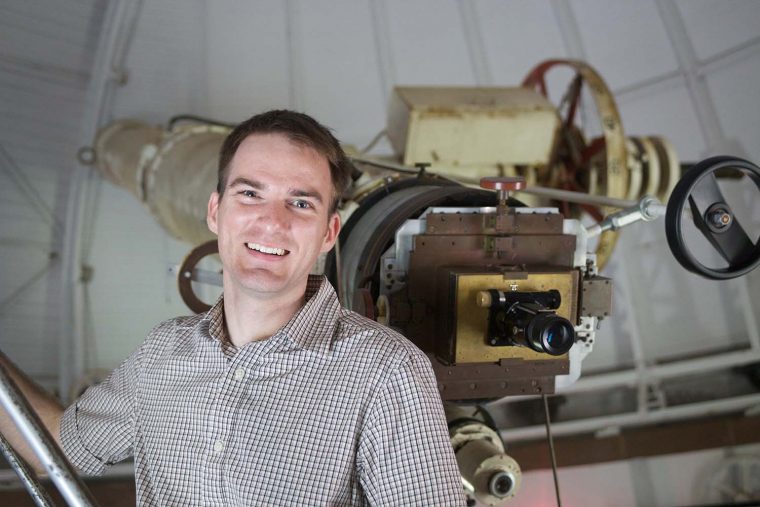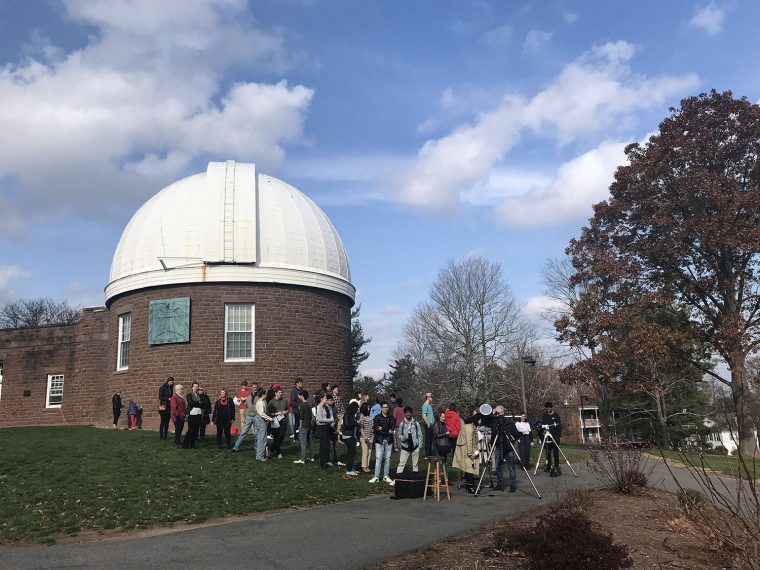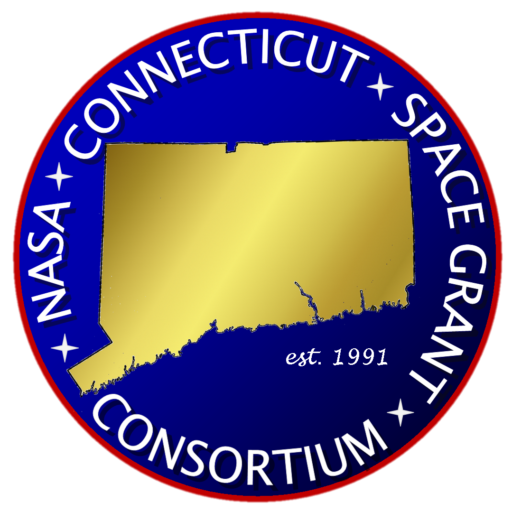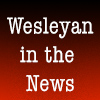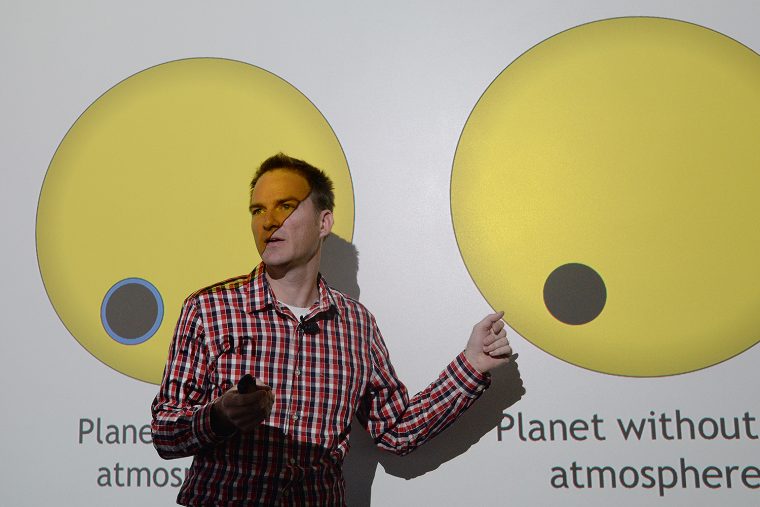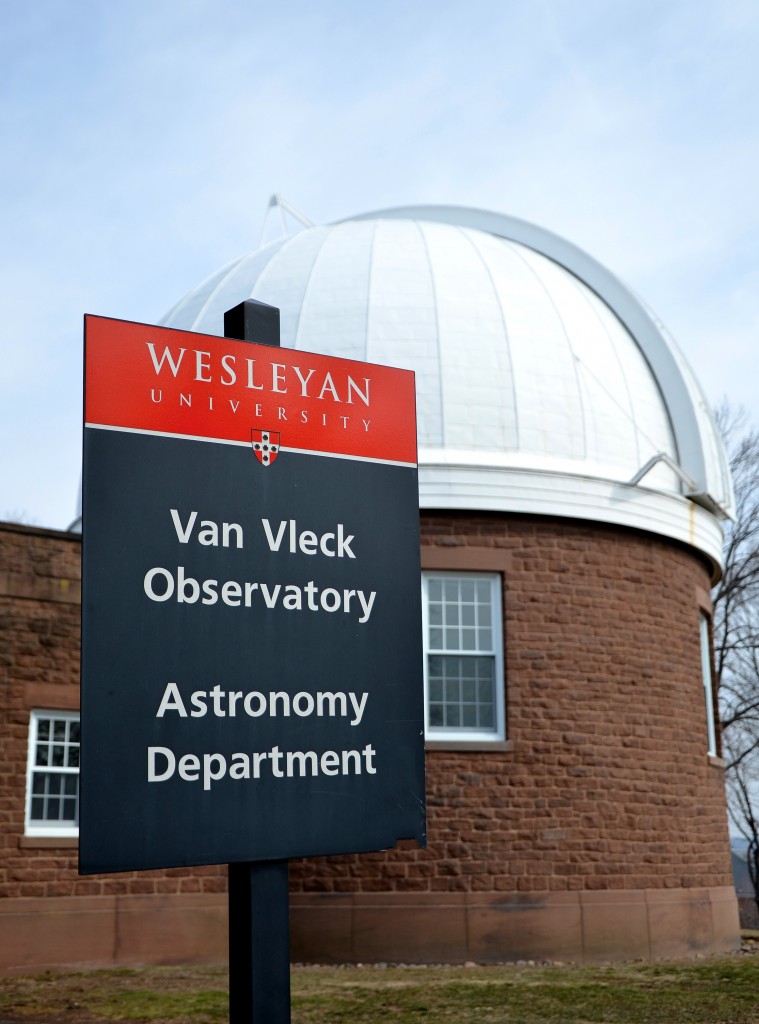If a spacecraft were to quickly travel outside the solar system—potentially en route to a nearby exoplanetary system—it would need to pass through an atmosphere unfamiliar to scientists on Earth. As a recipient of a $415,000 grant from NASA, Seth Redfield, chair and associate professor of astronomy, hopes to learn more about the mysterious makeup of this "outer space." "There are several very early designs for an interstellar probe, but first, we need to understand the properties of the space in between the stars if you are traveling through it, especially at high speed," Redfield said. "Given the vastness of…
For only the seventh time since Wesleyan’s founding, the planet Mercury passed directly in front of the sun, from the perspective of Earth—and Wesleyan served as a gathering place from which to learn about and observe the event. Faculty and students from Wesleyan’s astronomy department, as well as others from the University and the greater Middletown community, gathered outside the Van Vleck Observatory on Nov. 11 to witness the transit through three telescopes. The mild weather and partly cloudy conditions—particularly at the beginning and end of the transit (which lasted from 7:35 a.m. to 1:04 p.m.)—made for good viewings through…
Two graduate students and three undergraduate students are recipients of Fall 2018 NASA Connecticut Space Grant Consortium (CTSGC) awards. They are among 39 students from 13 CTSGC academic affiliate institutions to be honored. NASA CTSGC is a federally mandated grant, internship, and scholarship program that is funded as a part of NASA Education. There are Space Grant Consortia in all 50 states, plus Washington, D.C., and Puerto Rico. Earth and environmental science graduate student Christina Cauley received an $8,000 Graduate Research Fellowship for her project “Chemistry and Biology of Giant Hydrothermal Mounds in Paulina Lake, Oregon." Her advisor is Joop…
In this recurring feature in The Wesleyan Connection, we highlight some of the latest news stories about Wesleyan and our alumni. Recent Wesleyan News 1. Los Angeles Times: "As the World Warms, Deadly and Disfiguring Tropical Diseases Are Inching Their Way Toward the U.S." In this op-ed, Professor of Biology Frederick Cohan and Isaac Klimasmith '20, both in the College of the Environment, write that infectious disease is a growing threat, resulting from climate change, that humans may find hard to ignore. Cohan is also professor, environmental studies and professor, integrative sciences. 2. Hartford Courant: "Trump's Immoral Response to Climate Report" Gary Yohe, the…
On Oct. 15, Seth Redfield, associate professor and chair of astronomy, gave a lecture at the Morrison Planetarium at the California Academy of Sciences. He was invited to speak as part of the Benjamin Dean Astronomy Lecture series. The title of his talk was, "Exploring Our Galactic Neighborhood." The talk will be posted to the Academy's iTunes University site. Redfield is also associate professor, integrative sciences, and co-coordinator, planetary science.
The Association of Universities for Research in Astronomy (AURA), which operates the Hubble Space Telescope, the James Webb Space Telescope, the U.S. National Optical Astronomy Observatory (NOAO), and other major astronomical research facilities in the United States, has elected the Keck Northeast Astronomy Consortium (KNAC)—led by Wesleyan University—as a new member. This historic development represents the first time that liberal arts institutions have been invited to join the association and serves as an important recognition of the value of such programs, not just to education, but also to frontier research in astronomy. “This is a tremendous recognition of the important…
(more…)
Wesleyan Associate Professor of Astronomy Seth Redfield and astronomy student Julia Zachary '17 recently reported at the 229th meeting of the American Astronomical Society on their research using data from the Hubble Space Telescope combined with two Voyager spacecraft probes, both very long-lived and successful NASA missions. The findings were shared in dozens of news outlets from the U.S. to India to Afghanistan. According to Nature.com, "The work is a rare marriage of two of the most famous space missions — and an unprecedented glimpse at the realm between the stars." “If the Voyager spacecraft and the Google Street View car are going…
Four Wesleyan undergraduate students have received grants from NASA's Connecticut Space Grant Consortium. Astronomy major Hannah Fritze '18 was awarded $5,000 for an Undergraduate Research Fellowship Grant titled, “Searching for Intermediate Mass Black Holes in Ultraluminous X-ray Binaries.” This grant will support her research this coming semester on black holes with Roy Kilgard, support astronomer and research associate professor of astronomy. Avi Stein '17, who is majoring in astronomy, was awarded $1,000 for a Student Travel Grant. He will be presenting his research on Venus—conducted with Martha Gilmore, the George I. Seney Professor of Geology, professor of earth and environmental sciences—at…
(more…)
Wesleyan's Van Vleck Observatory is celebrating its centennial this spring, with a series of events and an exhibition beginning in early May. On May 6, the observatory's library will reopen to the public with an exhibition on the history of astronomy at Van Vleck. Developed by a team of faculty, students, and staff, the exhibition will use the observatory's extensive collection of scientific instruments, teaching materials, photographs, drawings, and correspondence to illustrate both the changes in astronomical research and teaching over the past century, and the observatory's consistent mission of conducting instruction and research under the same roof. The exhibition will…
Two faculty members and three students have been awarded grants in the latest call for proposals from NASA's Connecticut Space Grant Consortium. Jim Greenwood, assistant professor of earth and environmental sciences, and Bill Herbst, the John Monroe Van Vleck Professor of Astronomy, professor of integrative sciences, were awarded $8,000 for a Faculty Collaboration Grant titled “Chondrule Formation Experiments.” This is to run high-temperature experiments on material that makes up meteorites in order to test a hypothesis that they put forward in a recent paper in Icarus this year. Seth Redfield, associate professor of astronomy, associate professor of integrative sciences, was awarded $1,500 for a STEM Education…


